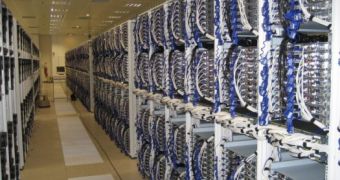Elizabeth Cochran, a seismologist at University of California, is up for making an earthquake monitoring system via distributed computing a reality for every user. The Riverside's distributed computing project researcher is able to save lives through the implementation of Quake-Catcher Network, which should use accelerometers that are already installed in laptops, as well as the spare processing power to monitor for any seismic activity.
Hard-disk drives in modern laptops are protected by accelerometers from mechanical failure caused by sudden impacts. These are a perfect solution for the Quake-Catcher Network's monitoring system, as they are already designed to measure vibrations. The project also includes the designing of an USB dongle seismometer to be used with desktops. Because the keyboard smashing on desktop PC's might be an issue, the dongle will monitor the accelerometers only after three minutes of system inactivity.
The underground seismic sensors installed to monitor the southern California send the received data to one of several universities. It takes about 15 to 20 seconds before the data is analyzed, a gap that would be eliminated. The monitoring through the network would do everything in real-time, thanks to the way distributed networking works. The network monitoring would give people 10 to 15 seconds to prepare themselves for the shock waves, acting as an early warning system.
Another good part of this earthquake monitoring system would be the possibility of gathering the seismic data to map the event. Seismologists would be given this way a time line as well as more information on material density of the earthquake and its distance. All the results would be available for the public and researchers at no costs.
The team has the program working on Mac laptops at the moment, but the team intends to implement it on HP and IBM laptops this summer. Elizabeth Cochran is working on the project along with Jesse Lawrence of Stanford University and the software architect and consultant Carl Christensen. From about 300 testers worldwide, 100 are from the United States. As soon as the testing is completed, the researchers plan to make the software available on BOINC, which also runs other popular distributed computing projects like SETI@home and ABC@home.
Computer enthusiasts are familiar with some of these distributed computing projects, such as SETI@home and Folding@home. Given its Cell Broadband Engine, Sony's PlayStation 3 can run Folding@home very well. Microsoft also used a Folding client for the Xbox 360, and its ATI-powered GPU easily rises up to Sony's PlayStation 3 performance, even if the processor is a little bit slower.
When it comes to distributed computing, the idea is to take advantage of those times when the computer is not used. Many clients use these semi-inert cycles by crunching numbers for a specific project. For example, Folding@home uses these times to study protein folding interactions, while SETI@home analyzes radio waves from space to find signs of extraterrestrial life. Other clients do many other things this way. As the amount of data gathered through these distributed computer networks is huge, the earthquake monitoring system would just take advantage of an already existing base.

 14 DAY TRIAL //
14 DAY TRIAL //